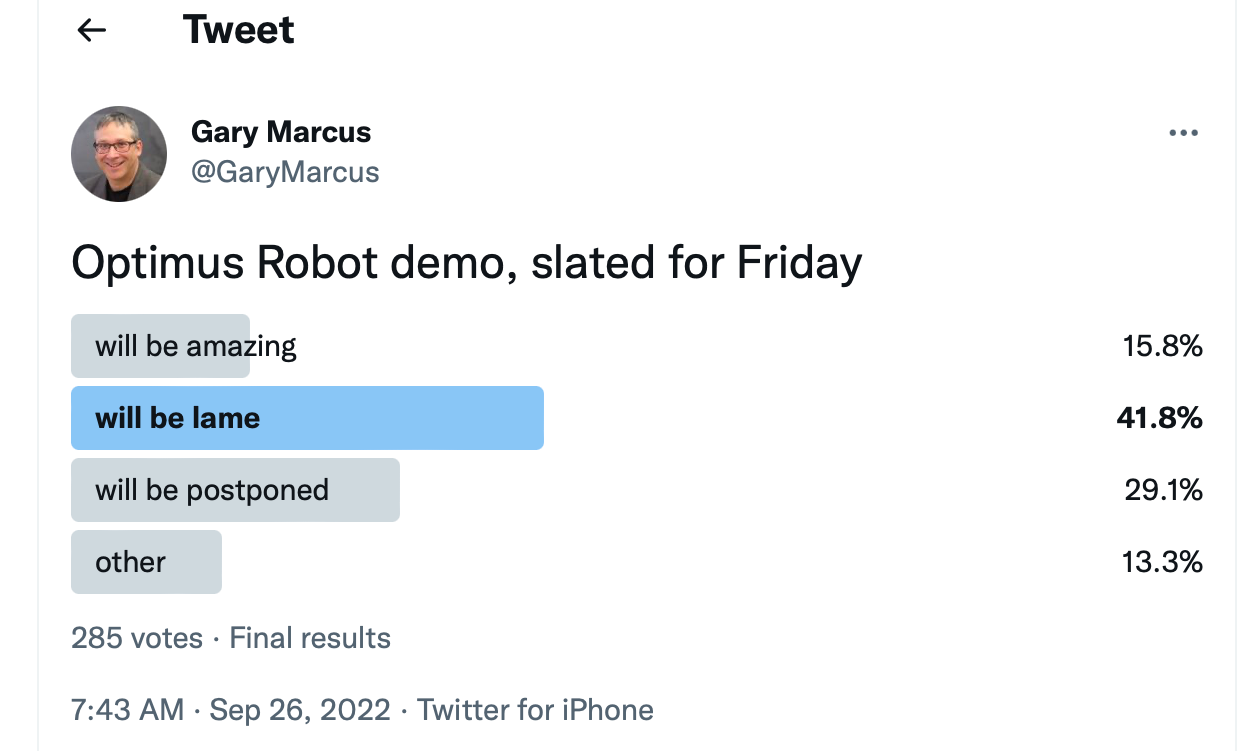The Musk Bros, who ever they are, have high hopes for Friday’s update on Tesla’s Optimus robot:

My own followers are (perhaps not surprisingly) a bit less sanguine:
With tongue slightly in cheek, but genuine skepticism, here my Top 5 reasons why my own expectations are quite low:
Reading tea leaves is not really my business, but sometimes the signs seem hard to miss. A couple days Buzzfeed asked Musk for comment, in advance of the announcements. How much progress have you made since last year when you announced the Optimus robot. Musk’ answer—“I hate BuzzFeed with the passion of a thousand suns.” —wasn’t exactly a ringing endorsement. (Usually CEOs say things like “Fantastic! We are really proud of what we will be showing you on Friday!”)
Musk is almost never right about deadlines. He been promising driverless cars pretty much ever year since 2014 and still hasn’t yet gotten that project out of beta, and the thing that is in beta isn’t still isn’t really a driverless car at all, so much as a car that can drive for you some of the time, provided you pay really strict attention all of the time. The fleets of driverless taxis he promised are likely still years or decades away.
Musk may well have been scooped! The thing that I suspected Musk most wanted to do has already been done: take a large language model (like GPT-3) and hook it up to robot. That could have made for a cool demo, bu t… Google just beat him to the punch. In my view the Google demo is pretty problematic (despite being cool), particularly in terms of likely reliability, but no matter. If Tesla does something similar, nobody knowledgeable will impressed.
Last time around, Tesla displayed a person in a robot costume dancing; turning that to real robotic life in itself would mean nothing. Boston Dynamics already knows how to build whole chorus lines full of actual dancing robots (and robots doing parkour and somersaults and so forth). If all we saw was more of the same— canned demos of amazing physical feats—everyone would yawn. The real challenge is to get a robot to behave flexibly in the real world.
The most important concern is that robotics is always harder than people think it is. To take one example from many, OpenAI made a huge splash with their Rubik’s cube robot demo in October 2019, but apparently shut the whole thing down last year, never shipping anything that looked remotely like a product, despite the immense press. Building robots in the lab is one thing, making them work in the open-ended real world is another. To impress those in the know, you would probably have to show that you had made sort of significant progress towards the so-called Sim2Real problem, of getting simulated robots to work reliably out in the world. Roboticists are likely to scoff unless they see real evidence of progress than on Friday. That disconnect, between what works in simulation and what happens in the real world, is particularly pernicious—and particularly relevant—if Musk ultimately wants his robots to work in ordinary people’s homes (and ordinary workplaces). And it here’s where I suspect Musk has gone wrong: techniques that apply to driverless cars (which mostly have to deal with that roads are governed by more or less the same rules wherever you) may have little value in the varied environments of human homes, which are often littered with pesky and unpredictable things like stairs and today and pets that pose serious problems for humanoid robots. And you really don’t want Optimus to fall on your cat.
The real problem w robots has never been demos, anyway (there have been many, for decades); it’s making robots in robust in the real world. One more dancing robot wouldn’t tell us much about whether Tesla was close to (say) a real general-purpose domestic robot, and the robotics community would be rightly skeptical if that’s all that we saw.
As the excellent journalist James Vincent just put it in his own analysis the real question is not what do we will we see in Friday but rather how deep is the tech. As he put it, when the bot “is unveiled on Friday, be sure to watch it closely and ask yourself: what am I seeing here, a tech demo or stage show?” That’s what professionals will be doing.
None of this is to say that Tesla could not solve all of these problems eventually given enough time and money, but Friday may not be the big demo his fans are hoping for.




Great column -- very relevant and to the point.
I agree.... but... I enjoyed Tesla AI last year (even the dancing robot :) and I've arranged my schedule so no work this Friday to see the next Tesla AI day. Wonderful feeling.... (sort of like walking into Radio Shack many, many years ago when they sold discrete components and with $20 I could buy parts and and solder and build anything that afternoon.... although what it turned out was garbage but ok for a kid). Who knows what Elon Musk is going to build with the tools he has available. It won't be AGI. (But I'm sure insane brute force computing, a lot of cool designs, a better future for all of us, etc....)
Robust robotics will not *readily* occur (other ways to achieve it also) until you solve causality (compositionality is solved automatically), spatial binding problem, temporal binding problem, grounding problem and put Spelke into a massively parallel architecture. Tesla will not achieve or demonstrate any of that on Friday.... but I'm still looking forward to it.
The need to create hype is once again overwhelming the need to make progress. The AI world is becoming like a business that can only focus on short-term goals.